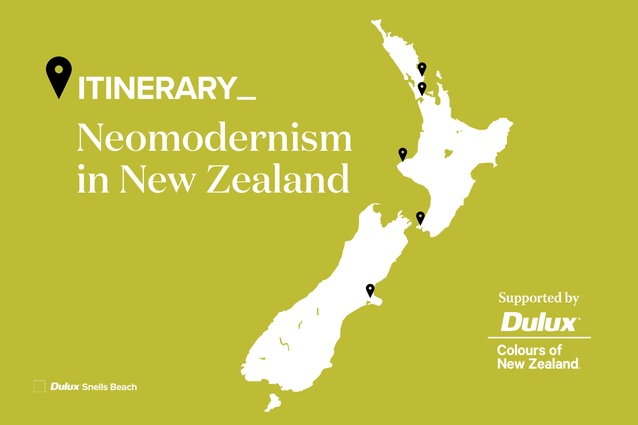Itinerary: Neomodernism in New Zealand
In this month's itinerary, supported by Dulux Colours of New Zealand, Andrew Barrie takes a tour of 14 Neomodernism buildings in New Zealand.
As the 20th century accelerated towards its end, the shifting directions of global architecture were marked by a couple of key exhibitions at the Museum of Modern Art in New York. The Deconstructivist Architecture show in 1988 presented seven mostly fairly young figures with work that demonstrated an aesthetic of fragmentation and deep scepticism towards modern architecture’s dogmas. MoMA’s Light Construction show of 1995 hailed a return to modernist calm, but one that emphasised new qualities — transparency, luminescence and visual ambiguity. The ‘emerging sensibility’ was tightly defined, but the 33 projects in the show were by a variety of architects, many of whom would set the agenda for the 21st century — Norman Foster, Steven Holl, Jean Nouvel, Toyo Ito, Kazuyo Sejima, Renzo Piano, Herzog & de Meuron and Peter Zumthor.
Intriguingly, the Light Construction show also included the majority of the architects from the Decon show — Rem Koolhaas, Zaha Hadid, Frank Gehry and Bernard Tschumi — figures that would define some of global architecture’s key directions in the 21st century. This indicates that Decon was, for most, a fruitful moment rather than an enduring methodology, and that those (mostly older) architects who chose the other conspicuous path — postmodern classicism — found it led to territory that was much less fertile in the longer term.
New Zealand had its own influential exhibition around that time. The 1950s Show, which opened in late 1992 at Auckland Art Gallery, marked the recognition of our local modern architecture as worthy of appreciation and preservation. Modernism not only moved beyond the concern of historians and heritage campaigners but reappeared as a neomodern strain in contemporary design.
In many ways, this marked a conservative turn in New Zealand architecture. The 1980s had seen architects drawing from a wider range of sources (especially classical architecture) and most of our local leading figures adopted PoMo languages. In the 1990s, many seemed simply to transfer this historicist impulse from classicism and other pre-modern styles back to the ‘tradition’ of modernism. We didn’t see much scepticism towards modernism or a strong drive to develop new spatial or surface qualities.
Where the internationals spoke about finding an architecture for the electronic age or of exploring new material possibilities, the most common 1990s’ reference point for Kiwis was the timber modernism of The Group. This was most brutally expressed when a World Architecture Festival judge, presented with a high-end Kiwi house in a spectacular alpine setting, told a story about how “when he was growing up in the sixties, his parents had bought him a book on modern architecture. ‘Your building was in there,’ he told [the architects]. ‘You’re quite old fashioned, aren’t you?’.”
But the new modes slowly seeped in. Some of the most striking local examples of work picking up these ideas were residential. Thom Craig’s own house (1996) in Christchurch absorbed ideas from the ‘Light and Space’ artists of California. At the Ponatahi House (2003) in the Wairarapa, Architecture + wrapped the elevated volume of a huge country house in glass bearing layered text by poet laureate Jenny Bornholdt.
With new software allowing the design of complex forms, and new materials coming on stream, the 1990s and 2000s were an era of expanding architectural possibilities, these in turn reflecting the increasingly digital, nomadic and simulated society of the moment. A time of technological optimism, it echoed the 1950s and ’60s, perhaps further explaining the appeal of that past era as a reference point. But, as in the 1970s, when the real costs of consumption and growth became clear, the question in the 2010s became — and remains — how to pull back from the brink.
THE ITINERARY
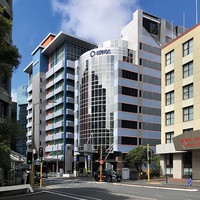
1. 1988 — Sun Alliance House
139 The Terrace, Wellington
Structon Group
If pluralism is the defining characteristic of postmodernism, this project demonstrates the philosophical postmodernity of our local neomodern aesthetic; this office building combined architectural languages that might otherwise have been seen as divergent. Designed by a young Stuart Gardyne and occupying a complex urban site, it integrates horizontally banded PoMo side walls with front and rear façades of tautly curved neomodern glazing, while the street entry is marked by angular, aesthetic-of-fragmentation canopies. The project received an NZIA National Award in a special Urban Context category in 1989. Refer Architecture NZ May/June 1989.
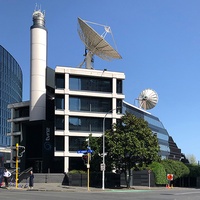
2. 1989 — Television New Zealand Network Centre
100 Victoria Street West, Auckland
Warren and Mahoney
Like Sun Alliance in Wellington, this project is an artful alloy, combining elements of what was then Warren and Mahoney’s past, present and future. It dates from the peak of the firm’s postmodern arc, but smoothly integrates its PoMo elements (banded granite and glass) with the firm’s earlier ‘constructivism’ (expressed structural frames) and later neomodernism (sleek glass skin). The building housed state-of-the-art news facilities that made it the most technically demanding project Warren and Mahoney had yet undertaken. The complex received NZIA Regional and National Awards in 1990. See Architecture NZ Nov/Dec 1989.
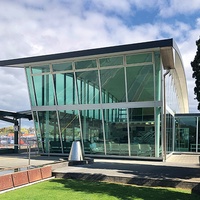
3. 1993 — Christchurch Railway Station
Troup Drive, Christchurch
Warren and Mahoney
Designed by émigré Thom Craig, this project aligned Warren and Mahoney’s work with the international mainstream of neomodernism — thin planes, swooshing curves, extensive glazing and shimmering metal. The central gesture here is a delicate roof arcing over an all-glazed passenger hall. Emphasising the transparency of this main space, it is buttressed by solid volumes clad in silver corrugate, their walls at a jaunty angle that suggests motion. Intriguingly, a long garden courtyard, enclosed by the glazed terminal, a garden wall and the platform, recalls one of Warren and Mahoney’s modernist gems — Harewood Crematorium (1963). See Architecture NZ May/June 1994.
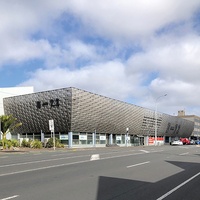
4. 1996 — D72
72 Dominion Road, Auckland
Patterson Architects
The refurbishment of a 1960s’ commercial building, this project was defined by a silvery new skin of woven, perforated aluminium strips. Intended to create street presence and limit solar gain internally, the weaving also signalled Pattersons’ interest in Polynesian culture and patterns. The key change internally was the introduction of an oval-shaped courtyard space with a landscaped centre framed by more woven strips and, in turn, the building’s main horizontal and vertical circulation routes. The building received a BOMA Award in 1996, an NZIA Branch Award in 1999 and an NZIA Regional Award in 2000. See Architecture NZ May/ June 1997.
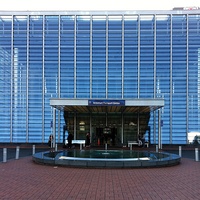
5. 2003 — Britomart Transport Centre
12 Queen Street, Auckland
Jasmax and Mario Madayag
Following a master plan competition won by Mario Madayag, Jasmax, and Peter Walker and Partners, the Chief Post Office was adapted as the station’s entrance hall and the descent to the underground rail lines was cleverly inserted into a vertiginous louvred glass box. Stainless-steel mesh forms a seamless ceiling to the spectacular subterranean platform hall, with shimmering abstract ‘trees’ designed by Michael Parekōwhai completing the sense of visual haze. Highly photogenic, the project’s spatial and aesthetic oomph was evidenced in the number of television commercials and music videos in which the complex appeared. See Architecture NZ May/June 2004.
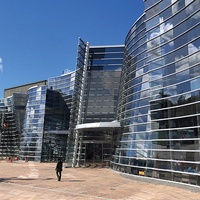
6. 2003 — Christchurch Art Gallery Te Puna o Waiwhetū
312 Montreal Street, Christchurch
Buchan Group
Another project resulting from a competition, this scheme plays light against heavy. The bulk of the building’s functions — exhibition and back-of-house spaces — was housed in solid boxes but the spacious foyer and hospitality spaces were wrapped by a collection of undulating glass façades. This glittering wall of faceted glass frames a large, landscaped forecourt but peels open to create entries. The building’s solidity paid unexpected dividends during Christchurch’s earthquake season, when it served as a key centre for rescue and recovery efforts in the much-damaged city centre. See Architecture NZ May/ June 2003.
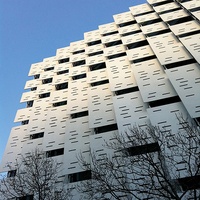
7. 2005 — School of Business
42 Wakefield Street, Auckland
Jasmax
A clever response to a tricky Auckland University of Technology site, a V-shaped plan orients 10-storey slabs of classrooms and offices to the urban frontages and a glazed atrium to a newly pedestrianised side street. The highly visible street façade has been formed from a set of floating, thin-edged screens, their surfaces activated by perforations resembling old-school computer punched cards. Functionally, this deep façade shields the building from traffic noise and solar gain, and internally directs views towards charming city skyline vistas. The project received an NZIA Supreme Award in 2006. See Architecture NZ Sept/Oct 2005.
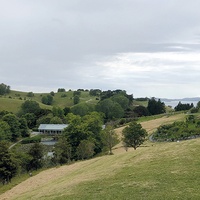
8. 2007 — The Glass House
17 Arabella Lane, Snells Beach
Noel Lane Architects
Kiwi moderns had long pointed to the agricultural shed as a key inspiration for architectural ‘New Zealandness’, an odd approach that seemed to assume other nations didn’t have sheds. Here, Noel Lane took a different approach to rural heritage, finding a point of intersection between our vernacular of agricultural glasshouses, the Case Study-style expression of structure and volume, and the surface effects of neomodernism. Bridging a small lake, this glass building is the hospitality centre for Brick Bay Wines and the gateway to the Brick Bay Sculpture Trail. The project received an NZIA New Zealand Award in 2007. See Architecture NZ May/June 2007.
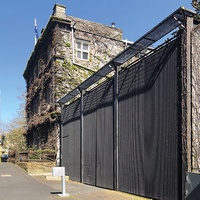
9. 2009 — Northern Club Wintergarden
19 Princes Street, Auckland
Fearon Hay
The key space of this project is a glassy events room but the project doesn’t play with transparency or reflectivity. Placed next to the Club’s distinctive ivycovered classical pile, the Wintergarden is an assertive but ambiguous street presence, the big move being to tuck the glassy volume behind a floating veil of black steel grills. Complex surfaces have remained a theme in Fearon Hay’s work – standouts are the draped, plant-covered mesh of Te Kaitaka at Auckland Airport (2014) and the fluted perforated metal façade of the Kauri Timber Building (2016) at 104 Fanshawe Street, Auckland.
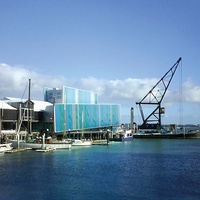
10. 2009 — Voyager NZ Maritime Museum
149 Quay Street, Auckland
Bossley Architects
The building’s floating Danpalon polycarbonate façade, with its subtle watery colouring, demonstrates spectacularly the visual haze that characterised Light Construction internationally. The surface reflects the shimmering harbour and sky during the day, and, at night, is lit from within to form a glowing lantern. Built as an extension to the NZ Maritime Museum, this building was designed to house NZL 32, Black Magic, the yacht with which Sir Peter Blake won the America’s Cup for New Zealand in 1995. Bill McKay wrote: “There aren’t many buildings that look as good as boats, but this one does.” See Architecture NZ Mar/Apr 2010.
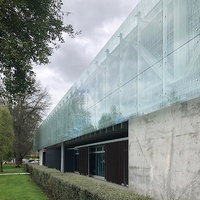
11. 2009 — NZi3 Innovation Institute
69 Creyke Road, Christchurch
Warren and Mahoney
Stretching along a street frontage at the University of Canterbury, this building is, in many ways, a showcase for the campus beyond. An elevated glass box cantilevers boldly over the surrounding landscape. The sense of lightness is emphasised by a façade configured as a floating plane of white-fritted glass clouding the view of the white steel structure behind. A hothouse for research and innovation, the content of the building within this sophisticated wrapping is relatively simple: the ground floor houses display and meeting spaces while the upper floor is an open workspace. See Architecture NZ Mar/Apr 2009.
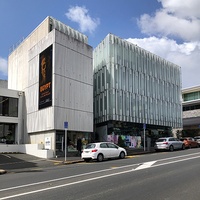
12. 2012 — Geyser
100 Parnell Road, Auckland
Patterson Associates
In 1998, Andrew Patterson completed Site 3, a mixed-used commercial building for tenants, with an operable façade of solid, zinc-covered shutters. Following a similar brief and employing a similar massing of low-rise blocks forming courtyards and laneways, this building shows increased sophistication — six Green Star certification — and lightness of approach. The façade treatments include double-layer fritted glass and textured GRC panels. The effect is decorative but there is underlying functionality — automatic opening panels trap warm air in winter and allow ventilation in summer. Winner of an NZIA National Award in 2013. See Architecture NZ Nov/Dec 2012.
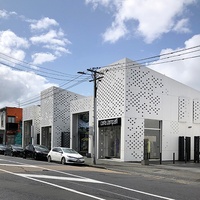
13. 2012 — Mackelvie Street Precinct
59 Mackelvie Street, Auckland
RTA Studio
Perforated screens and veils, often employed by the Light Construction architects, have long been an RTA Studio favourite. Here, prismatic white forms are set out along the street frontage. Cunning planning and detailing allow a seemingly thin skin to detach from the weatherline behind, such that the perforations create a remarkable play of solidity and lightness. The lacy forms stood in stark contrast to their surroundings when built but are now part of a whole RTA Studio neighbourhood that includes the firm’s own offices on Pollen Street (2016) and Objectspace (2017) on Rose Road. See Architecture NZ Jan/Feb 2013.
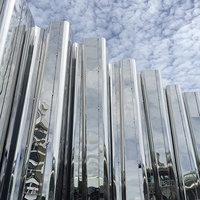
14. 2015 — Len Lye Centre
42 Queen Street, New Plymouth
Patterson Associates
Perhaps our building most perfectly adapted to the visual sensitivities of the Instagram age, this project was designed to celebrate Len Lye’s oeuvre and is inspired by the flickering energy — Lye called it “zizz” — his works embodied. The building dissolves into a haze of distorted reflections, cityscape and sky. Lye would have loved the marriage of high and low; the façade of swirling, highly polished stainless steel was made by skilled locals who normally build equipment for breweries and milk factories. A Kiwi icon. See Architecture NZ Sept/Oct 2015.
OTHER ADDRESSES
Kate Edger Information Commons (2003)
9 Symonds Street, Auckland
Warren and Mahoney
Built alongside Warren and Mahoney’s solid 1960s’ Students’ Union, this complex dissolves its edges with floating glass and mesh.
Trinity Apartments (2005)
429 Parnell Road, Auckland
Architectus
The volume’s solidity is dissipated by a screen of glass fins.
The Dowse Art Museum (2006)
45 Laings Road, Lower Hutt
Athfield Architects
Sir Owen G Glenn Building (2008)
12 Grafton Road, Auckland
FJMT with Archimedia
582 K’ Road (2008)
582 Karangahape Road, Auckland
RTA Studio
21 Queen Street (2009)
21 Queen Street, Auckland
Peddle Thorp Aitken
Supreme Court of New Zealand (2010)
85 Lambton Quay, Wellington
Warren and Mahoney
Wrapped in a bronze façade designed with sculptor Neil Dawson.
Botanic Gardens Visitor Centre (2013)
Botanic Gardens, Christchurch
Patterson Associates
Whanganui Collegiate Administration Building (2019)
132 Liverpool Street, Whanganui
RTA Studio
SOURCES
The books that best capture this moment internationally are Charles Jencks’ The New Moderns (New York: Rizzoli, 1990) and the catalogue of the MoMA show — Terrence Riley’s Light Construction (New York: Museum of Modern Art, 1995). More locally, The 1950s Show had its own catalogue published as a souvenir edition of New Zealand Home & Building magazine; it can still often be found in local second-hand bookshops. Many of the local firms cited have published monographs — see Amanda Hyde de Kretser (ed.), Architectus: Bowes Clifford Thomson (Auckland: NZ Architectural Publications Trust, 2004), New Territory: Warren and Mahoney (Auckland: Balasoglou Books, 2005) and Stephen Stratford’s Pete Bossley Architects (Auckland: NZ Architectural Publications Trust, 2005). The anxiety-inducing story of the New Zealand presentations at the first World Architecture Festival in Barcelona in 2008 was told by John Walsh in Architecture NZ Jan/ Feb 2009.

The itinerary series is supported by Dulux Colours of New Zealand. Dulux Colour Specialist Davina Harper has selected a Colours of New Zealand palette based on this itinerary. See the full range and order colour samples here.


